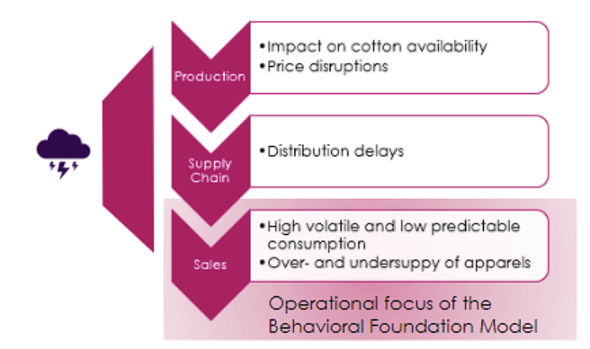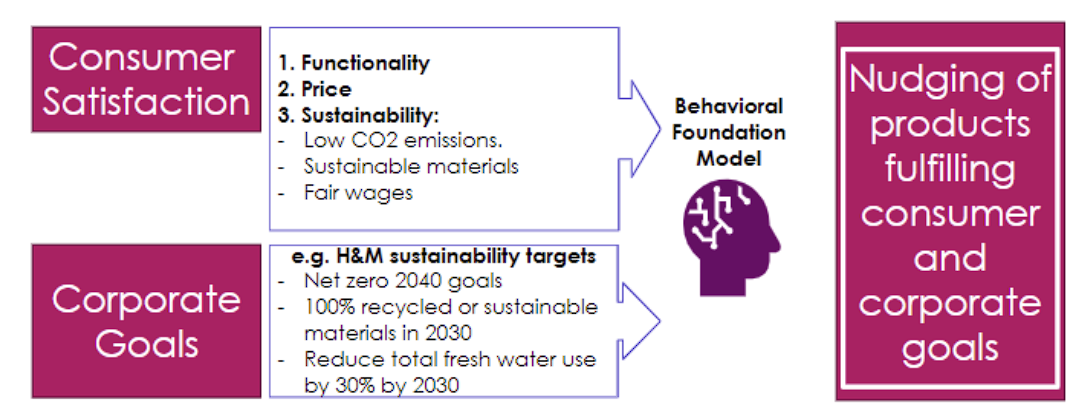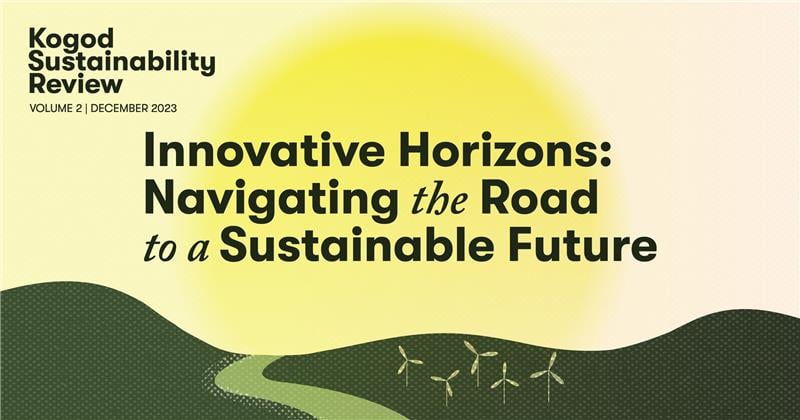
Lukas Adamski and Victoria Portela
MS in Sustainability Management Students, Kogod School of Business
Written by Lukas Adamski and Victoria Portela with collaboration in findings from Madison Doring and Bhagyrashree More.
Introduction
The fast fashion industry, driven by persistent consumer demand for affordable and trendy apparel, operates in a competitive landscape with rapid shifts in consumer trends. Weekly production and distribution of new products are common practices, often prioritizing cost-efficiency over environmental and social considerations. Artificial Intelligence (AI), particularly the Behavioral Foundation Model (BFM), emerges as a crucial tool to alleviate the adverse environmental, social, and governance (ESG) impacts associated with the mismanagement and waste in the fast fashion sector, and concurrently mitigates financial losses. This paper delves into three key applications of the BFM in the fashion industry, specifically addressing returns management, weather volatilities, and overall corporate ESG strategy.
Fast Fashion & Sustainability
Historically, global brands prioritized cost reduction and typically outsourced production along with the responsibility for environmental and social issues to subcontractors in developing economies like Bangladesh and Vietnam (WTO 80). However, today’s fast fashion industry contributes enormously to global environmental issues. Therefore, it is imperative for brands to be accountable for concerns related to social and environmental sustainability. To elaborate, 8.8 percent of global carbon emissions are emitted by the fashion industry. At the same time, the fast fashion industry is responsible for 1.7 percent of the global GDP (Statista 3). This comparison highlights the carbon-intensive production and distribution process of the fashion industry. Environmental issues such as waste production, water pollution, and excessive water use are linked to this industry. Furthermore, the negative social impact of the fast fashion industry, known for poor working conditions and health and safety concerns, is often criticized. Fast fashion is also considered one of the most polluting industries (Dzhengiz et al.) — it is not only a contributor to climate change but will be affected by the physical and transitional risks of the climate crisis such as severe weather events or changing weather patterns (Oh et al.). Simultaneously, the evolving consumer inclination towards sustainable products is increasing (refer to Figure 1).

Figure 1: Sustainability offers great opportunities to the fashion industry (Boyea-Robinson 23; Baier et al. 10; Ninimäki 160; Am et al. 3)
Since this trend towards sustainable consumption is carried especially by younger generations and strengthened by the existential fear of climate change (First Insight; Petro), we expect it to lead to lasting changes in trends in the fashion industry. Thus, early adoption of the BFM to enhance sustainability performance can create a sustainable competitive advantage (SCA) by reducing the risk of sustainability-related regulations and building long-lasting brand loyalty. Thus, to mitigate ESG-related risks and maintain attractiveness to consumers, fashion brands must drastically transform their business operations in a sustainable way.
AI: Introduction to the Behavioral Foundation Model
Artificial Intelligence (AI) is a popular buzzword, loved and feared simultaneously. This technical revolution will offer new opportunities and can be used to increase corporations’ sustainability performance, including within the fast fashion industry. In this analysis, we focus on the Behavioral Foundation Model (BFM). Foundation models are AI neural networks, which are trained with excessive raw data. Through unsupervised, systematic learning, the AI determines categories, correlations, and trends within this raw data (Nvidia). The BFM specifically tracks and analyses consumer behavior data mostly in online stores, but also in retail stores. It automatically determines any changes and correlations in behavioral data triggered by seasonal, interseasonal, or other trends. Based on these findings, it can nudge the best product fit for the customer, tailoring the experience to each user individually. Visualized, this means that the AI will understand if a customer is interested in sustainability and thus will nudge sustainable products for purchase.
Below are the applications of the BFM to address three significant challenges within the fashion industry, which were determined through interviews with industry experts and academic research.
Returns Mitigation
The fashion industry contends with a notable surge in e-commerce sales, thereby amplifying the environmental repercussions associated with e-commerce returns such as carbon emissions, packaging waste and apparel waste (Tait). According to McKinsey & Company's post-COVID-19 survey on returns management, the return rate for apparel escalated from 25 percent to 35 percent during the pandemic (McKinsey A). Our team conducted five anonymous interviews with global apparel companies in July 2023, and we found that they typically experienced a return rate range of 25 to 40 percent, contingent on product type and functionality.
Fashion companies often implement lenient return policies to foster customer loyalty and sustain ongoing sales despite the ensuing negative environmental impact and additional costs."

Lukas Adamski and Victoria Portela
MS in Sustainability Management Students, Kogod School of Business
The BFM emerges as a viable solution to partially mitigate return challenges by assimilating returns data from preceding seasons, the AI discerns the likelihood of returns for various products. Through a nudging and notification system, the AI can dissuade customers from excessive purchases where the system may refrain from promoting additional products of the same type if they are already in a customer’s basket. This approach redirects advertising efforts towards other apparel which will not further increase the return probability of the shopping basket. For example, if a winter jacket is already in the basket, the BFM would not nudge additional winter jackets but instead actively advertise head coverings, gloves, and other supplements. Furthermore, the BFM has the potential to determine customer sizes based on homepage behavior and correlates it with peer group behavior and historical returns data without explicit size information. This insight allows for targeted nudges towards clothes of anticipated sizes, thereby enhancing operational efficiency without compromising sales.
Weather Predictions
A significant challenge highlighted by industry leaders and academic research is the impact of weather volatility on apparel sales (e.g., Oh et al., 2021). While seasonal climatic trends are well-integrated into business operations, short-term weather events exert a notable influence on consumer behavior, contributing to the inherently volatile and unpredictable nature of the fashion industry's consumer market. For instance, during weeks or months of unusually harsh weather in the summer, sales of summer apparel decrease, while inadequate stocking of rain protection and outdoor apparel occurs, and vice versa. This mismatch results in unsold apparel, leading to unnecessary waste and carbon emissions. Particularly in cases where the design and production processes have extended timelines, accommodating short-term weather volatility becomes challenging in the sales strategy (McKinsey B).

Figure 2: how weather volatilities affect fashion companies.

Figure 3: reduce sales volatility through AI consumer behavior predictions.
By assessing the historical and current impact of weather changes on consumption and extrapolating future changes based on weather predictions, AI can provide valuable insights. In an environment characterized by high volatility and uncertainty, such as weather prediction, BFM excels in using consumer behavior patterns, combined with automatic learning, to perform analyses that can assess the correlation between weather and sales. This integration empowers the fashion industry to enhance distribution efficiency by aligning apparel inventory with regional stores based on real-time consumption changes influenced by weather volatility. Consequently, this approach minimizes waste and reduces associated CO2 emissions by more accurately selling and advertising clothing that meets current weather patterns, and therefore are more likely to be sold instead of going to a landfill.
Corporate Sustainability Goals
Fast fashion companies, under the escalating influence of the climate crisis and evolving consumer awareness, are adopting corporate sustainability goals exemplified by H&M's commitments like net zero by 2040 and 30 percent recycled or sustainable materials by 2030 (H&M, 7ff). While these systemic goals are valuable for mitigating the industry's environmental impact, their realization demands substantial organizational restructuring across the supply chain and processes, presenting uncertainties regarding achievement.
The challenge lies in designing and producing new sustainable apparel that aligns with consumer preferences. The industry grapples with an attitude-behavior gap, where consumers may express concern about the climate crisis but still prioritize factors like price and design over sustainability in their purchasing decisions. Bridging this gap between consumer interests and purchasing behavior necessitates an effective communication strategy tailored to individual consumer decision drivers.

Figure 4: efficient management of consumer as well as corporate goals.
Companies encounter dilemmas in steering customers towards sustainable alternatives instead of best-selling products integral to brand identity. Changing the material composition of these products without compromising their appeal poses a significant challenge. The BFM can track and analyze online consumer behavior, identify individual decision drivers, and can prioritize sustainable products with the nudging system. This strategic nudging approach enables the promotion of attractive, sustainable alternatives, influencing consumer choices without explicitly emphasizing sustainability. This software-driven mechanism holds the potential to significantly reduce a fashion company's environmental footprint by shifting consumption towards more sustainable options.
Conclusion
The fashion industry can benefit greatly from the BFM as this model offers a multifaceted approach, enabling fashion companies to simultaneously reduce their environmental footprint and enhance sustainability performance by targeting consumer behavior and spending habits. Key applications can include return mitigation, optimized distribution based on real-time weather-influenced consumption patterns, and an overarching improvement in sustainability through personalized nudging strategies.
Our findings illustrate the substantial impact and potential of the BFM in sustainability. Addressing return challenges, optimized distribution, and implementation of customer-specific nudging strategies can lead to tangible improvements in environmental and sustainability metrics such as waste and emissions reduction. These are only three possible applications, additional opportunities could be utilized by using the BFM to collect product data and automize reporting. The overall positive impact of this new technology can only be determined after implementation, thus, fashion companies should conduct a thorough analysis of this innovative technical solution to unlock its full potential to make sustainability part of their business model.
Citations
Am, Jordan Bar, et al. “Consumers Care about Sustainability-and Back It up with Their Wallets”. McKinsey & Company, 6 Feb. 2023, www.mckinsey.com/industries/consumer-packaged-goods/our-insights/consumers-care-about-sustainability-and-back-it-up-with-their-wallets.
Baier, Daniel, et al. “The Drivers of Sustainable Apparel and Sportswear Consumption: A Segmented Kano Perspective.” Sustainability, vol. 12, no. 7, Apr. 2020, p. 2788. https://doi.org/10.3390/su12072788.
Boyea-Robinson. “The Social Impact Advantage”. Nov. 2022, p. 23.
Dzhengiz; Haukkala; Sahimaa. “(un)sustainable Transitions Towards Fast and Ultra-fast Fashion”. Fashion and Textiles, 25 Nov. 2023, https://doi.org/10.1186/s40691-023-00337-9.
First Insight. “The State of Consumer Spending: Gen Z Shoppers Demand Sustainable Retail”. First Insight, Jan 14, 2020. https://www.firstinsight.com/white-papers-posts/gen-z-shoppers-demand-sustainability
Greg Petro, Gen Z Is Emerging As The Sustainability Generation, Forbes, Apr 30, 2021, https://www.forbes.com/sites/gregpetro/2021/04/30/gen-z-is-emerging-as-the-sustainability-generation/?sh=f26f1ba86995
H&M. “Annual and Sustainability Report 2022”. H&M, 24 Nov. 2023, https://hmgroup.com/wp-content/uploads/2023/03/HM-Group-Annual-and-Sustainability-Report-2022.pdf
McKinsey A. “A Path Toward Healthy, Sustainable Growth in E-commerce”. McKinsey, 24 Nov. 2023, https://www.mckinsey.com/industries/retail/our-insights/solving-the-paradox-of-growth-and-profitability-in-e-commerce.
McKinsey B. “Faster Fashion: How to Shorten the Apparel Calendar” McKinsey, 24 Nov. 2023, https://www.mckinsey.com/industries/retail/our-insights/faster-fashion-how-to-shorten-the-apparel-calendar.
Niinimäki et al. “Eco-clothing, Consumer Identity and Ideology”. Sustainable Development, Vol. 18, Issue 3, pp. 150–162, https://doi.org/10.1002/sd.455.
Nvidia. “What Are Foundation Models?”. Nvidia, 24 Nov. 2023, https://blogs.nvidia.com/blog/what-are-foundation-models/.
Oh, J., et al. “Use of Weather Factors in Clothing Studies in Korea and Its Implications: A Review.” Asia-Pacific Journal of Atmospheric Science, Apr. 2022, pp. 729–41. https://doi.org/10.1007/s13143-022-00279-0.
Petro. “Gen Z Is Emerging As The Sustainability Generation”. Forbes. Apr 30, 2021. https://www.forbes.com/sites/gregpetro/2021/04/30/gen-z-is-emerging-as-the-sustainability-generation/?sh=f26f1ba86995
Statista. “Shared Apparel: A Statista Dossier Plus on the Global Apparel Market and Its Potential for Collaborative Consumption”. Statista, 24 Nov. 2021, https://www.statista.com/download/MTY2NTMxMzE4MCMjMjkwMjYzIyM4MTEzMiMjMSMjbnVsbCMjU3R1ZHk=
Tait, Amelia. “Buy. Return. Repeat … What Really Happens When We Send Back Unwanted Clothes?”. The Guardian, 25 Nov. 2023, https://www.theguardian.com/global-development/2023/mar/31/what-happens-when-we-send-back-unwanted-clothes.
WTO. “Share in world exports of the leading clothing exporters in 2022, by country”. In Statista, Jul. 31, 2023, https://www.statista.com/statistics/1094515/share-of-the-leading-global-textile-clothing-by-country/
